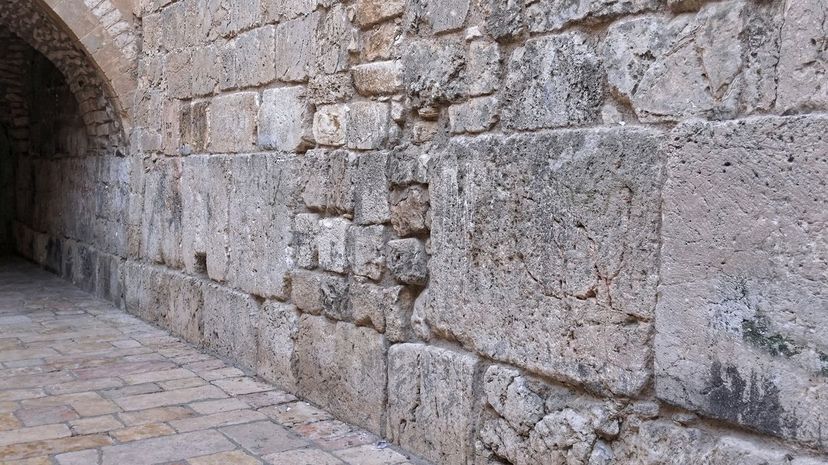
About This Quiz
Cozy up to one of the most challenging religion quizzes on the internet. This is a test where a few or more peeks inside your Good Book won't save you. Pass this challenge, and you're ready to teach your Bible school instructors!
Our holy drill has all the elements of the perfect biblical challenge. We sort through and present the most obscure details imaginable. Don't be fooled by any simple questions that you might come across because they shall require difficult answers. Intricate knowledge of ordinary Bible tales is needed, so focus less on the purpose of Noah's Ark, for example, and more on the Ark's specific measurements and the significance of those numbers.
Indeed, even well-studied Bible scholars are likely to get stumped by these sacred calisthenics. Bible brainiacs spend numerous hours absorbing facts regarding entire biblical empires. King Nebuchadnezzar is always a scholar's syllabus favorite. We, too, include kings, like Nebuchadnezzar, but we delve deeper into the less flattering aspects of their rulerships - again, where all the obscure info tends to dwell. Understanding the difference between their royal greatness and regal infamy will help you win big points here.
We've divulged enough hints and Bible wisdom to prepare you for this challenging quiz. It's time to roll up your sleeves and click the best answers possible. Onward, soldier!

The first four books of the New Testament - Matthew, Mark, Luke and John - are called gospels, which record the life events of Jesus Christ. The first three gospels are referred to as synoptic gospels because these books express the same points of view about Jesus' life.

According to Daniel 4, King Nebuchadnezzar first summoned the wise men of Babylon to interpret his troubling dream but they failed to interpret it. "But at the last Daniel came" and the prophet, "whose name was Belteshazzar," was able to decipher the king's dream.

Matthew 27 teaches that Judas eventually "cast down the pieces of silver in the temple ... and went and hanged himself." This story of Judas is also found in the New Testament gospels Mark, Luke and John.
Advertisement

According to Matthew 4:18, Jesus was "walking by the sea of Galilee" when he spotted "two brethren, Simon called Peter, and Andrew his brother, casting a net into the sea: for they were fishers." Jesus said to them, "Follow me, and I will make you fishers of men."

A publican was a tax collector in ancient times. The Jews perceived Zacchaeus to be sinner, so he "sought to see Jesus" to defend his wealth and profession, saying, "Behold, Lord, the half of my goods I give to the poor," as illustrated in Luke 19.

The Old Testament book of Psalms is a collection of an individual's responses to God. Responses range from woeful cries to expressions of extreme joy. Christians recite the psalms for group worship, as well as individual worship.
Advertisement

These names are referenced in Exodus 1, where "the king of Egypt spake to the Hebrew midwives," saying, "When ye do the office of a midwife to the Hebrew women, and see them upon the stools; if it be a son, then ye shall kill him ..."

Peter prompted the miracle, as recorded in Matthew 14, by asking Jesus "bid me come unto thee on the water," after the disciples saw Jesus walking on the sea and were "troubled." Verse 29 confirms that Peter "walked on the water, to go to Jesus."

Exodus recounts the story of the children of Israel and their struggle for freedom against pharaoh's Egypt. In Exodus 7:19, God speaks to Moses, leader of the people, saying, "Take thy rod, and stretch out thine hand upon the waters of Egypt ... that they may become blood ..."
Advertisement

The first book of the Old Testament, Genesis, is also the first book of the Bible. The book of Malachi, which contains only four chapters, is the last Old Testament book and focuses on correct comportment during the worship of God.

Revelation is the last book of the New Testament, as well as the last book of the Bible. Its official title is "The Revelation of Jesus Christ," and the book portrays Jesus as several manifestations, including "Lion of the tribe of Juda (Judah)," "the Bridegroom" and "Son of man."

The eponymous New Testament book of Titus was named for a Greek who was the son of Gentile parents. After his conversion to Christianity, Titus accompanied Paul to Jerusalem where Judaists insisted that Titus be circumcised - a dictate that Apostle Paul repudiated.
Advertisement

Matthew is the first book of the New Testament, and Mark, 2 Peter and Jude are New Testament books. Numbers is the fourth of the first five Old Testament books known as the Pentateuch.

The gospel of John distinctly presents Jesus as "the Word," God who became man. For this reason, John's book focuses on the divine miracles of Jesus more than than the other gospels - Matthew, Mark and Luke.

In the book of Exodus, God is presented as the savior, as well as the chief provider of the children of Israel. God's acts of salvation constitute the first half of the book, and his benevolent laws for his children comprise the second section of Exodus.
Advertisement

Apostle John authored 3 John where he explains, in verse 9, how one called Diotrephes "loveth to have the preeminence" among those in the church to whom John addresses this epistle. Diotrephes was guilty of talking disparagingly against John and other brethren.

Genesis 4 informs that "Adam knew Eve ... and she conceived, and bare Cain, and said, I have gotten a man from the Lord." Eve later bore Cain's brother Abel, who "was a keeper of sheep, but Cain was a tiller of the ground."

Genesis 11 describes how the sons of Noah traveled to "a plain in the land of Shinar; and they dwelt there." On this land, they decided to build "a city and a tower, whose top may reach unto heaven" so that they could make a name for themselves.
Advertisement

First Samuel 17 offers that "Saul and the men of Israel ... pitched by the valley of Elah" where they fought the Philistines. David volunteered to fight Goliath, and he prevailed with a sling and a stone.

The last verse of the Bible, Revelation 22:21, is "The grace of our Lord Jesus Christ be with you all. Amen." In Revelation, Jesus Christ gives specific directions to the churches, and the book warns of the "wrath of the Lamb."

Korah is renowned for rebelling against Moses and allowing greed to cloud his judgment. Numbers 16:30 explains how Korah and others who provoked God's wrath were swallowed up by the Earth.
Advertisement

The exact verse, Colossians 4:6, specifies, "Let your speech be alway with grace, seasoned with salt ..." In the New Testament book, Paul admonishes the Colossians to stay devoted in prayer and thanksgiving.

The Levites were the only tribe among the Israelites of whom a census was not taken, in the book of Numbers. According to the book, "the Levites after the tribe of their fathers were not numbered among them."

The book of Nahum, which only contains three chapters, tells of the destruction of Nineveh for its wickedness. Actual destruction occurs in the last chapter: "Woe to the bloody city! It is all full of lies and robbery; the prey departeth not."
Advertisement

Second Samuel 21:12 explains how "David went and took the bones of Saul and the bones of Jonathan his son from the men of Jabesh-gilead" and "buried they in the country of Benjamin ..." David and his men fasted to express their sorrow for the first king of Israel.

The prophet Daniel interpreted the handwriting on the wall, "Mene, Mene, Tekel, Upharsin," as recorded in Daniel 5:25. The prophet predicted the destruction of Belshazzar's kingdom for his rebelliousness.

Second Samuel 19 communicates how Barzillai "was a very aged man, even fourscore years old: and he had provided the king sustenance while he lay at Mahanaim ..." David's aged helper's greatest desire, however, was to die and be buried in his own city.
Advertisement

Second Kings 10:11 clearly states, "Jehu slew all that remained of the house of Ahab in Jezreel ... until he left him none remaining." God, through prophet Elisha, anointed Jehu as king of Israel.

Second Chronicles 1:1 is the source of this verse, and it is referring to King David's son Solomon. Chronicles addresses the restored community of Israel, who questioned whether the promises that God issued under Davidic rule were still valid.

First Kings 1 confirms David's condition: "Now king David was old and stricken in years; and they covered him with clothes, but he gat no heat." His servants brought their king a "fair damsel throughout all the coasts of Israel" to minister to him.
Advertisement

As it is written in Matthew 17:1, "... after six days Jesus taketh Peter, James, and John his brother, and bringeth them up into an high mountain ... and was transfigured ..." Old Testament figures Elias (Elijah) and Moses appeared with Jesus during the miracle.

Acts 9 describes Ananias as "a certain disciple at Damascus" whom God instructed to seek Saul of Tarsus in the house of Judas. The disciple obeyed and put hands on Saul, "that he might receive his sight."

Second Kings 5 tells the story of Naaman's ordeal with leprosy. Naaman, "captain of the host of the king of Syria," sought prophet Elisha's help to cure his condition. Though he did not agree with Elisha's recommendation at first, Naaman eventually obeyed and was healed.
Advertisement

Born in Egypt to slaves, Joshua was tasked to lead the children after Moses was not allowed to enter the promised land due to his disobedience. According to Numbers 34:17, "Eleazar the priest" helped Joshua divide the land among the Israelite tribes.

During his earthly life, Jesus cast out seven demons in Mary Magdalene. She was his faithful servant in life, as well as in death. Mary Magdalene had first mistook the resurrected Christ for a gardener, according to John 20:15.